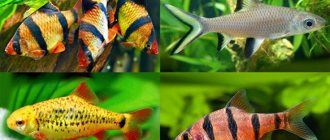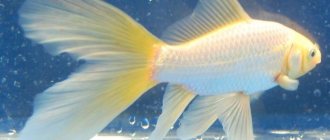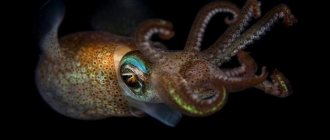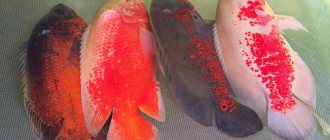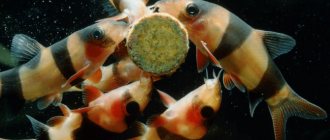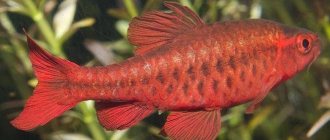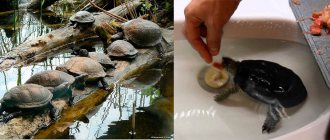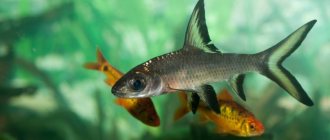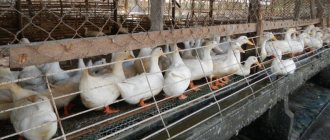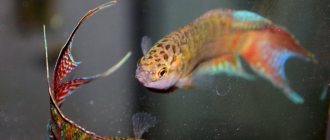Koi carp or brocade carp (eng. Koi, Japanese 鯉) are ornamental fish bred from the natural form of the Amur carp (Cyprinus rubrofuscus). The birthplace of the fish is Japan, which today remains a leader in breeding and hybridization. This fish is not recommended for keeping in an aquarium. Koi carp are kept in ponds, as the fish are cold-water and large. And they don't feed you in winter. In addition, breeding it is not difficult, but getting high-quality fry is the opposite.
origin of name
The word koi and nishikigoi come from the Chinese 鯉 (common carp) and 錦鯉 (brocade carp) in Japanese. Moreover, in both languages these terms referred to different subspecies of carp, since in those days there was no modern classification.
What can I say, even today there is still no consistency in the classification. For example, Amur carp was recently a subspecies, but today it is already considered a separate species.
In Japanese, the word koi is a homophone (sounds the same but spelled differently) to the word love or affection.
Because of this, fish have become a popular symbol of love and friendship in Japan. On Boys' Day (May 5), the Japanese display koinobori, a decoration made from paper or fabric with a design of a koi carp on it.
This decoration symbolizes courage in overcoming obstacles and is a wish for success in life.
Benefits of keeping aquarium pets
Koi carps are often kept in an aquarium, however, for such pets it is necessary to use a large container. Among the advantages of such aquarium fish it is necessary to note:
- fish of this family are undemanding in care;
- calm character, rarely attack neighbors;
- carps live in any water;
- omnivorous, can eat vegetables and fruits;
- quickly get used to a change of environment.
Can be kept in the same aquarium with other species of fish. At night they sleep more and are rarely active.
History of creation
There is no exact information about the origin. It is believed that the common carp was brought to China by traders or that it came there naturally. And from China it came to Japan, but here the traces of traders or settlers are already clearly visible.
In written sources, the first mention of koi occurs in the 14th-15th century. Local name is magoi or black carp.
Carp are an excellent source of protein, so farmers in Niigata Prefecture began artificially breeding them to supplement their rice-poor diet during the winter months. When the fish reached a length of 20 cm, it was caught, salted and dried in reserve.
By the 19th century, farmers began to notice that some carps had changed. Red or white spots appeared on their body. Who, when and why came up with the idea of breeding them not for food, but for decorative purposes is unknown.
However, the Japanese have been engaged in breeding work for a long time; for example, the world owes the appearance of many goldfish to them. So breeding for beauty was only a matter of time.
Moreover, the selection work also included hybridization with other types of carp. For example, at the beginning of the 20th century, carp were crossed with mirror carp from Germany. Japanese breeders named the new variation Doitsu (Germany in Japanese).
The real boom in breeding came in 1914, when some breeders presented their fish at an exhibition in Tokyo. People from all over Japan saw the living treasure and over the next years dozens of new variations appeared.
The rest of the world also learned about koi, but they were able to spread widely around the world only in the sixties, along with the advent of plastic containers. In it, carps could be sent to any country without the risk of losing the entire batch.
Today they are bred all over the world, but they are considered to be the best in Niigata Prefecture. Koi are one of the most sought after ornamental fish in the world. You can find breed lovers in almost every country.
Adviсe
All types of koi are popular among aquarium hobbyists. To ensure that fish breeding does not cause difficulties, you can use the following tips:
- It is recommended to place the aquarium on the floor. Often when growing fish, stands cannot support much weight;
- You should not use specialized food that is sold by weight. Hermetically sealed bags retain all the nutritional qualities of the feed;
- which does not feel well in water with foreign odors;
- at night it is necessary to turn off the lights so that the fish can sleep;
- In order for the koi fish to remember its owner, it is recommended to feed it by hand.
In order for living conditions to be similar to natural ones, it is recommended to use special bacteria to clean the aquarium. Such biological organisms make fish resistant to diseases.
Description
Since this is a pond fish kept for its appearance, large fish are valued. The normal size for koi is considered to be from 40 cm to a record 120 cm. Fish weigh from 4 to 40 kg, and live up to ... 226 years.
At least the oldest documented koi in history lived to this age. Its age was calculated by the layers in its scales, since in carp each layer is formed once a year, like rings in trees.
The record holder's name is Hanako, but besides him, the age of other carp was also calculated. And it turned out: Aoi - 170 years old, Chikara - 150 years old, Yuki - 141 years old, etc.
The color is difficult to describe. Over the years of selection, many variations have appeared. They differ from each other in color, color and shape of spots, the presence or absence of scales and other characteristics.
Types of carp KOI
Although their number is practically endless, amateurs are trying to classify the breeds. Below is a partial list of varieties.
- Gosanke: the so-called big three (Kohaku, Sanke and Showa) Kohaku: white body with bright red spots
- Taisho Sanshoku (Sanke): tri-colored, white body with red spots and small black spots. Created during the Taisho era
- Showa Sanshoku (Showa): Black body with red and white spots. Were created during the Showa era
Possible diseases
Koi often suffer from diseases if not properly cared for. Diseases can be of the following types:
- carp pox - manifests itself in the form of growths on the fins and tail. Most often, the disease manifests itself in early spring. The disease affects the younger generation. Vitamin supplements are used for treatment;
- aeromonos - manifests itself most often if the fish is kept in a body of water; the first symptoms are ulcers on the body. The causes of the disease are sudden changes in water temperature. For treatment, antibiotics are used, which are poured into the water to eliminate bacteria;
- ascites is an inflammatory formation in the swim bladder, the body swells, and the fish float to the surface. The causes of the disease are improper care. This disease has no cure and can lead to death;
- epitheliocystosis - the formation of white growths on the gills. When formed, growths can complicate breathing and lead to death. It is recommended to isolate affected fish. Change the water and treat the container with antibacterial drugs;
- gopherellosis is a parasite that affects the kidneys. Parasites enter the body when using cheap food. There is no treatment; infected fish die.
When the first symptoms of the disease appear, the fish must be placed in a separate container. Otherwise, the infection will quickly spread throughout the entire population.
Koi carp in the pond
The koi carp themselves are unpretentious; with a normal balance in the reservoir, they only need to be fed.
Most often, owners are faced with the problem of clean water in the pond and achieve it using various types of filtration. The fact is that most of the reservoirs in which they live are too small and are not capable of providing independent, natural cleaning.
They require external filtration to remove waste products from the water before they kill the fish. A good filtration system contains both biological and mechanical cleaning methods.
We will not dwell on it separately, since there are now many options. Both ready-made and homemade.
The water temperature should be stable and not change significantly in a short period of time. Carps themselves are able to tolerate both low and high water temperatures.
But, again, if the reservoir is small, then the temperature fluctuations there are large. To prevent fish from suffering from them, the depth of the pond must be at least 100 cm.
The pond should also have steep edges that will deter predators such as herons from entering it.
Since the pond is located in the open air, the influence of the seasons is not very strong. Below you will learn what to look for at each time of year.
Spring
The worst time of year for carp. Firstly, the water temperature changes rapidly throughout the day.
Secondly, hungry predators appear, looking for tasty fish after a long winter or flight from warm countries.
Thirdly, water temperature +5-10ºC is the most dangerous for fish. The immune system of fish has not yet been activated, but bacteria and parasites are the opposite.
The best thing you can do for your koi at this time is to provide them with oxygen and a stable water temperature. Watch the fish carefully. Look for any warning signs of exhaustion or difficulty swimming.
You need to start feeding the fish when the water temperature rises above 10ºC. If they stand near the surface and ask for food, then this is a good sign.
At this time, it is better to use feed with a high content of wheat germ, as it is better absorbed.
Summer
The sunniest and hottest time of the year, which means maximum metabolism in fish and maximum activity of the immune system. In summer, koi can feed 3-5 times a day without harm to their health.
You just need to make sure that your filtration system is ready for this, as the amount of waste will increase sharply. And along with it, nitrates and ammonia.
Plus, if you don't have a large enough filter, your pond will end up looking like a bowl of pea soup!
Another thing to keep a close eye on during the summer is the oxygen level in the water.
The fact is that the higher the temperature, the less oxygen is dissolved and retained in it. The fish suffocate, stand still and may die.
To maintain oxygen levels in water, it is necessary to aerate it. In principle, this can be either a regular aerator, or a waterfall or water flow from a filter.
The main thing is that the mirror of the pond fluctuates. It is through vibrations of water that gas exchange occurs.
The minimum level of oxygen in water that Koi needs is 4 ppm. Keep in mind that 4 ppm is the minimum requirement, oxygen levels should always be well above this. Your koi need oxygen to live.
The ideal water temperature in summer is 21-24 ºC. This is the most comfortable temperature range for them.
If you have a shallow pond, the water temperature may rise to dangerous levels and your koi may be harmed. Provide cover or shade for your pond so they can get away from direct sunlight.
Koi love to eat bugs. Often at night you can hear splashing sounds on the water as they try to reach insects flying near the surface. Plentiful feeding and the added bonus of bugs make them grow very quickly.
Autumn
Everything falls - leaves, water temperature, day length. And the immune system. Poikilothermia or cold-bloodedness is also characteristic of carp. Their body temperature depends on the temperature of the water.
When the water temperature drops below 15ºC you will see the carp slow down. Again you need to monitor their health and behavior.
At this time it is time to prepare for winter. When temperatures begin to drop, switch to feeds that contain a high percentage of wheat germ and a low percentage of protein.
This mixture will be easy to digest and will help cleanse their digestive system.
Stop feeding your koi altogether when temperatures drop below 10C. They may look hungry, but if you feed them, the food in their stomachs will rot and they will suffer.
Keep your pond absolutely clean in the fall. This means removing leaves and other debris from your pond immediately. If you leave this in your pond throughout the winter, it will begin to decompose and release toxic gases.
Winter (wintering)
The further north you live, the more likely you are to see snow and ice, even though winters are mild.
Koi hibernate during the winter so they do not eat or produce any toxins. Do not feed koi if the water temperature is below 10C.
In winter, as in summer, you need to monitor the oxygen in the water; complete freezing of the surface of the reservoir is especially dangerous. It is better to turn off the waterfall at this time, as it makes the water temperature even lower.
At this time, the fish stays at the bottom, where the water temperature is slightly higher than at the surface. Its activity tends to zero, the carps fall into a state close to hibernation. Don't feed koi carp in winter!
Make sure that the water temperature does not approach +1C. Otherwise, ice crystals may form on the fish's gills.
Don't add salt to your pond. Salt lowers the freezing point of water, so if you add it to your pond, it can kill your fish as the water temperature can drop below freezing.
Reproduction
Koi carp breeding is carried out in a pond. There is not enough space in the container for the fish. In order to obtain offspring, a small nursery pond is used. Koi carp spawn for a short period. After the females lay their eggs, the adults return to the common pond. Because koi fish can eat eggs and fry. Fish breed in the reservoir in early spring and summer. Koi carp kept in an aquarium are not used for breeding, and regardless of gender, they can only increase in size, but not produce offspring.
Feeding
There are many factors to consider when feeding:
- Filter size
- Pond size
- Filter type and amount of time available to clean it
- How many fish do you have in your pond?
- What season is it now?
Summertime is a growth period for carp. In their natural environment, they will eat as much as they can in order to store fat to live off during the winter when food is scarce. You should feed high protein food during the summer to increase their growth rate.
Most people typically feed 2-5 times a day. If you feed them about 2-3 times a day, they will grow slower or even stay about the same size.
If you feed 3-5 times a day, they will grow quickly and reach their maximum size faster.
You must monitor the amount of feed; you don't want to overload your biological filter. If this happens, there will be a surge of ammonia and the fish may die.
Overfeeding can also cause harm through obesity and related health problems.
Koi can also be fed treats. They love oranges, grapefruits, lemons, watermelons, bread, earthworms, grubs and many other healthy fruits and vegetables.
Fruits such as oranges and grapefruits can be cut in half and thrown into the water, and the rest of the food can be chopped into pieces.
In the fall, when your pond temperature drops below 15ºC, you should start feeding a high wheat germ diet to help cleanse their digestive system.
When the water temperature starts to drop below 10ºC, you should stop feeding them altogether. When the water temperature gets this cold, your Koi's digestive system will shut down and any food that remains in it will begin to rot.
In winter, carp do not eat at all. Their metabolism slows to a crawl, so they only need their body fat to survive during the colder months.
In the spring their metabolism wakes up, so it's a good idea to feed them an easily digestible diet high in wheat germ.
You can start feeding them as soon as the water temperature in your pond is above 10ºC. A good sign is if carp start eating plants growing in the pond.
Start by feeding once a day and then gradually increase the amount. When the water temperature is consistently around 15ºC, you can start feeding a high protein diet.
A good food contains complete proteins and stabilized vitamin C, which does not break down within 90 days, like regular vitamin C.
Water requirements
Despite all the unpretentiousness of fish, they need to be provided with water with the required parameters. Water parameters are very easy to determine using chemical tests and a thermometer. For some, the pH of the water should be maintained between 7 and 7.5 (the indicator is equal to the neutral acid-base balance). The fish will not die if there is some shift towards increased acidity, but the pH should not be below 6. It is better to eliminate high acidity promptly, as it leads to a loss of color intensity. Acidity is of primary importance in maintaining a vibrant color.
Only minimal levels of nitrates in water are allowed. For this purpose filtering is provided. Numerous plants also reduce the rate.
Water hardness is an indicator that is kept in the range from 1 to 7. Special compounds will help with this. They are purchased at a pet store.
The water temperature varies significantly. Lonely fish do well at temperatures from 15 to 30 degrees. This allows you to do without a heater. Carps are strong fish, but it is easier for them to tolerate a decrease in water temperature by a couple of degrees than overheating.
Every new breeder needs to have the following cheat sheet.
Compatibility
It is not difficult to guess that pond fish are not compatible with tropical fish. The exception is some types of goldfish, such as the Shubunkin. But they are also a little more whimsical than pond koi.
Koi and goldfish
Goldfish appeared in China more than a thousand years ago, through selection from crucian carp. They have changed so much since then that goldfish (Carassius auratus) and crucian carp (Carassius gibelio) are now considered different species.
Goldfish came to Japan in the 17th century, and to Europe in the 18th. Koi fish were bred from Amur carp in 1820. Moreover, they are a color variation and if the color is not maintained, then after a few generations they turn into ordinary fish.
The length of carp reaches one meter and on average they grow at a rate of 2 cm per month. The largest goldfish will grow no more than 30 cm.
They are smaller, have more variations in body shapes, more color variations and longer fin lengths.
The variations have a common body shape and differ from each other only in color.
Some types of goldfish (regular, comet, shubunkin) are similar in color and body shape to koi and are difficult to distinguish before puberty.
Koi and goldfish can interbreed, but since they are different species of fish, the offspring will be sterile.
Sex differences
Males and females can be distinguished by their body shape. Males are longer and slimmer, while females are blimp-like. They are always wider than males, as they carry hundreds of eggs.
Because of this, many hobbyists keep only females, since the color of the fish is much more visible on a wide body. And for the same reason, females most often win at exhibitions.
But this difference clearly appears only over time, when the fish become larger and older.
Upon reaching sexual maturity (about two years), the difference between male and female becomes obvious.
